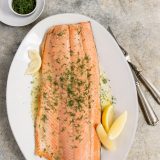French chef Michel Bras has a simple technique for turning out moist, tender salmon fillets: oven-poaching. We wondered whether it could be adapted to help us handle the holidays.
Bras cooks small cuts of fish in a 250˚F oven over a water-filled baking pan. The method works well because the delicate fish retains its moisture in gentle heat, so there is little chance of it drying out.
But perfectly cooking multiple salmon fillets—simultaneously—is difficult even using Bras’ technique, so we adapted his method by switching from individual servings to a large side of salmon. That gave us the volume we needed to feed a holiday-size crowd.
But moving a side of salmon can be challenging, so before we set it in a rimmed baking sheet, we created a foil sling for it to sit on. This made it easy to lift the cooked fish out of the pan once we were ready to place it on a serving platter.
To season the salmon, we wanted something to balance the fattiness of the fish. Since salt is essential for protein to absorb flavor, we gave the fish a quick bath in soy sauce. Just 15 minutes of soaking was perfect.
Bras uses water to oven-poach his salmon, but we saw the poaching process as an opportunity to add flavor. We combined chopped carrots, celery and shallot with thyme and dill sprigs, then scattered the mixture around the salmon. We then doused everything with dry vermouth, which not only provided the liquid for the poaching, but also added a layer of floral-herbal notes. We covered the entire arrangement with foil so that the salmon would cook in moist heat, becoming infused with flavor.
We gauged doneness using temperature rather than time; a digital thermometer the thickest end of the salmon gave us the most reliable results. After peeling back the foil to check the temperature, we pulled the fish out of the oven just before it reached the right temperature (120°F), then allowed gentle residual heat to finish cooking, bringing the foil-covered salmon to roughly 130°F.
While the fish was resting, we simmered ¾ cup of the residual cooking liquid, then stirred in butter, lemon juice and minced dill off heat to make a smooth, tangy sauce to spoon over the salmon. That, plus a little salt and pepper and a few lemon wedges, perfectly finished our salmon for a crowd.




